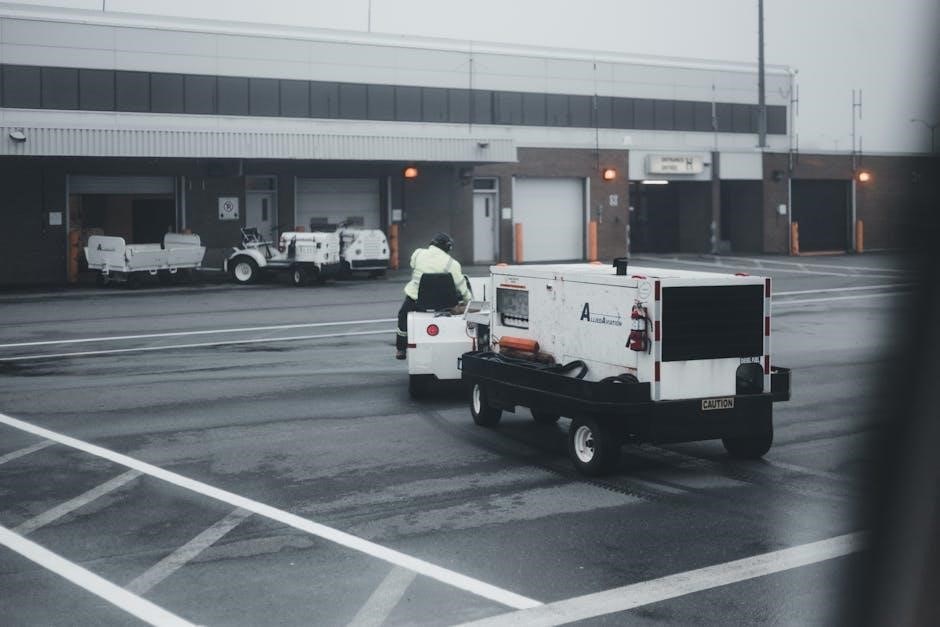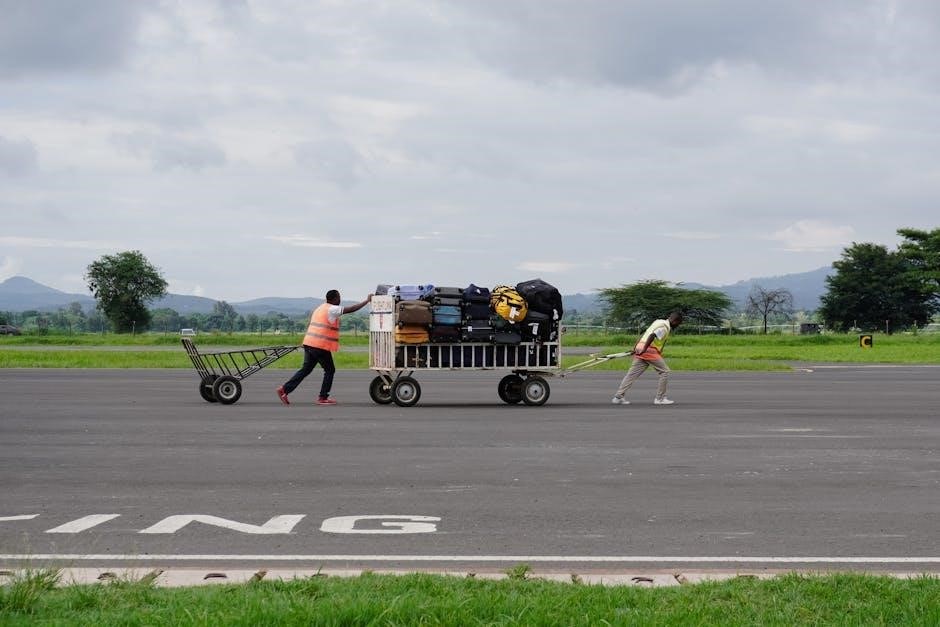Manual Dump Trailer: An Overview
What is a Manual Dump Trailer?
A manual dump trailer relies on mechanical manipulation‚ often using a hand-crank or lever system‚ to elevate and unload its contents. This differs from hydraulic systems‚ offering a simpler‚ less technologically advanced alternative.
Hydraulic dump trailers utilize a powered hydraulic system to lift the trailer bed‚ providing effortless unloading. Manual dump trailers‚ conversely‚ require physical effort to operate‚ making them suitable for lighter loads and situations where power isn’t available.
What is a Manual Dump Trailer?
A manual dump trailer represents a more traditional approach to material hauling and unloading. Unlike its hydraulic counterpart‚ it eschews the use of powered systems‚ instead relying on human power to raise the trailer bed and facilitate the dumping process. This type of trailer typically incorporates a hand-operated crank‚ lever‚ or winch mechanism that allows the operator to manually elevate the cargo bed to the desired angle for unloading. The simplicity of the design makes it a robust and reliable option‚ especially in situations where access to electricity or hydraulic power is limited. It is generally favored for smaller-scale operations‚ DIY projects‚ and environments where minimal mechanical complexity is desired. While requiring more physical effort‚ manual dump trailers offer a cost-effective and dependable solution for various material handling needs. They are typically lighter than hydraulic versions which could reduce the needed towing capacity.
Hydraulic vs. Manual Dump Trailers
The fundamental difference between hydraulic and manual dump trailers lies in their lifting mechanism. Hydraulic dump trailers employ a hydraulic system powered by an electric pump‚ allowing for effortless and rapid lifting of the trailer bed‚ even with heavy loads. This system provides precise control over the dumping process‚ ensuring efficient unloading. Conversely‚ manual dump trailers depend on human power to raise the bed‚ typically using a hand-crank or lever. While simpler in design‚ manual trailers require more physical exertion‚ making them better suited for lighter loads and smaller-scale tasks. Hydraulic trailers offer convenience and speed‚ while manual trailers prioritize simplicity and cost-effectiveness. The choice between the two depends on the user’s specific needs‚ budget‚ and the types of materials being transported. Manual dump trailers are also easier to maintain because of their lower complexity.

Types of Dump Trailers
Dump trailers come in various designs‚ each suited for specific applications. Common types include end dump‚ side dump‚ and bottom dump trailers‚ each offering unique unloading capabilities and advantages.
End Dump Trailers
End dump trailers‚ a prevalent type‚ are frequently employed for transporting diverse materials‚ notably excelling in hauling substantial loads to and from construction sites. These trailers unload by raising the front end of the trailer bed‚ allowing the material to slide out from the rear. Their design is particularly advantageous for delivering materials in a concentrated pile.
While they are versatile‚ end dump trailers require sufficient space for maneuvering during the unloading process. They are commonly utilized for transporting aggregates‚ construction debris‚ and other bulk materials. End dumps are not ideal for situations needing precise material distribution.
End dump trailers are frequently seen where materials are hauled to build up roadbeds and other mass deployment of materials.
Side Dump Trailers
Side dump trailers offer a distinct unloading method‚ tipping their cargo to the side rather than the rear. This capability proves especially useful in scenarios demanding material distribution along a linear path‚ such as road construction or landscaping projects. Contractors and construction managers will find these a valuable asset to their fleet.

The design often involves multiple tubs or compartments that can be independently emptied‚ offering enhanced control over material placement. Side dump trailers excel in stability during unloading compared to end dumps‚ reducing the risk of tipping.
They are well-suited for handling materials like gravel‚ sand‚ and road base. Because of the way the materials come out of the trailer‚ some do not work well with a side dump.
Bottom Dump Trailers
Bottom dump trailers‚ also known as belly dump trailers‚ release materials from underneath the trailer through a gate system. This design is ideal for continuous‚ controlled unloading‚ often employed in paving operations or spreading materials evenly over a large area. The high capacity of these trailers makes them efficient for transporting bulk materials like aggregates.
The ability to unload while moving distinguishes bottom dump trailers‚ allowing for precise material placement without halting the vehicle. This type of trailer is particularly advantageous in road construction‚ where consistent material distribution is crucial. Crop Chaser uses them for maximum control over the dump rate.

However‚ they may not be suitable for all materials‚ as sticky or cohesive materials can clog the bottom gates and impede unloading. The trailers are in high demand across construction‚ utilities‚ and agriculture.

Uses and Applications of Dump Trailers
Dump trailers are versatile tools used across various industries‚ including construction‚ agriculture‚ landscaping‚ and waste management‚ for efficiently transporting and unloading bulk materials.
Construction Sites
On construction sites‚ dump trailers serve as invaluable assets for hauling various materials. They are frequently employed to transport gravel‚ fill dirt‚ and aggregates‚ essential components in many construction projects. The ability to efficiently deliver these materials directly to the point of use streamlines workflows and reduces manual labor.
Furthermore‚ dump trailers are effective for removing construction debris and waste from the site. This includes materials like concrete rubble‚ wood scraps‚ and other unwanted items‚ keeping the area clean and organized. A clean construction site is safer and more efficient‚ contributing to overall project success.
The use of dump trailers ensures a continuous supply of necessary materials and facilitates the prompt removal of waste‚ optimizing productivity and minimizing delays. Their robust design and ease of use make them indispensable for construction operations of all sizes.
Agricultural Applications
In the realm of agriculture‚ dump trailers play a crucial role in various tasks‚ enhancing efficiency and productivity for farmers. During harvest season‚ these trailers facilitate the transport of crops from the field to storage or processing facilities. This includes moving grains‚ fruits‚ vegetables‚ and other harvested goods‚ streamlining the harvesting process.
Dump trailers are also instrumental in transporting livestock feed‚ ensuring animals have a consistent supply of nourishment. They can efficiently haul hay‚ silage‚ grains‚ and other feed materials‚ making it easier to manage livestock feeding schedules.
Additionally‚ farmers utilize dump trailers for clearing fields of debris and managing waste. This can involve removing rocks‚ branches‚ and other unwanted materials‚ maintaining field health and promoting optimal growing conditions. Their versatility makes them indispensable tools for modern farming operations.
Landscaping Projects
Landscaping projects benefit significantly from the utility of dump trailers‚ enhancing efficiency and reducing manual labor. Landscapers rely on these trailers for hauling essential materials such as mulch‚ soil‚ and heavy stones to project sites. This simplifies the transportation of bulk materials‚ allowing for quicker project completion.
Dump trailers are also invaluable for removing debris and waste from landscaping sites. This includes clearing away unwanted vegetation‚ construction remnants‚ and other discarded materials‚ maintaining a clean and organized work environment.
Moreover‚ dump trailers facilitate the transport of landscaping equipment‚ ensuring tools and machinery are readily available when needed. This streamlines operations and minimizes downtime‚ optimizing productivity for landscaping professionals. Their versatility makes them indispensable for a wide range of landscaping tasks.
Waste Management
Dump trailers play a crucial role in waste management‚ offering an efficient solution for hauling and disposing of various types of waste. These trailers are adept at transporting construction debris‚ yard waste‚ and general refuse‚ ensuring proper disposal practices.
For demolition projects‚ dump trailers are essential for removing rubble and discarded materials from the site. This facilitates site cleanup and prepares the area for subsequent development. Their robust design allows them to handle heavy and bulky waste items with ease.
Furthermore‚ dump trailers are utilized for collecting and transporting recyclable materials‚ supporting recycling initiatives and promoting environmental sustainability. By streamlining waste handling processes‚ dump trailers contribute to cleaner and healthier communities. Their versatility makes them an indispensable tool for waste management professionals.
Storm Cleanup and Demolition
Dump trailers are indispensable for storm cleanup and demolition projects‚ offering a practical means to efficiently remove debris and waste materials. During storm recovery‚ these trailers facilitate the removal of fallen trees‚ branches‚ and damaged structures‚ helping restore normalcy to affected areas.
In demolition projects‚ dump trailers are crucial for hauling away concrete‚ wood‚ and other construction debris‚ ensuring the site is cleared for redevelopment. Their robust construction enables them to handle heavy loads of rubble and discarded materials with ease.
By expediting debris removal‚ dump trailers contribute to safer and more efficient cleanup operations. This reduces hazards and accelerates the process of rebuilding and restoring damaged properties. Their versatility makes them an essential asset for disaster relief and construction professionals.

Advantages of Using a Dump Trailer
Dump trailers minimize manual labor by enabling efficient material unloading‚ reducing the need for extensive manpower and associated expenses. This results in significant cost savings for various projects.
Reduced Labor Costs
Dump trailers inherently lead to reduced labor costs by automating the unloading process. Instead of relying on manual shoveling or carrying materials‚ the trailer’s dumping mechanism efficiently dispenses the load. This reduces the number of workers needed for unloading tasks‚ translating to lower payroll expenses. Businesses can reallocate personnel to other critical tasks‚ optimizing workforce utilization. Moreover‚ the speed and efficiency of dump trailers minimize project completion times‚ further contributing to cost savings. By reducing physical strain on workers‚ dump trailers also mitigate the risk of injuries‚ lowering potential worker’s compensation claims and associated healthcare costs. In industries where bulk material handling is frequent‚ the labor cost reductions from using dump trailers can be substantial‚ providing a significant return on investment.
Increased Efficiency
Dump trailers drastically increase efficiency in material handling by enabling rapid and controlled unloading. Compared to manual methods‚ such as shoveling‚ dump trailers significantly reduce the time required to unload materials‚ accelerating project timelines. The ability to precisely position and discharge loads minimizes the need for manual adjustments‚ further streamlining operations; This enhanced efficiency translates to more projects completed within a given timeframe‚ boosting overall productivity. With faster turnaround times‚ businesses can accept more jobs and generate higher revenue. Dump trailers also optimize material flow on job sites‚ reducing congestion and improving workflow. The ease of operation and quick unloading capabilities of dump trailers contribute to a more efficient and productive work environment‚ ultimately leading to improved profitability and customer satisfaction.
Improved Safety
Dump trailers significantly enhance safety on job sites by minimizing the need for manual material handling‚ thus reducing the risk of strains‚ sprains‚ and other injuries associated with lifting and carrying heavy loads. By automating the unloading process‚ dump trailers keep workers at a safe distance from potential hazards‚ such as falling materials or unstable loads. Proper loading techniques and regular maintenance further contribute to a safer working environment‚ ensuring that the trailer operates reliably and predictably. Dump trailers also facilitate better organization of materials on site‚ reducing tripping hazards and improving overall site safety. The use of a body prop when performing maintenance prevents accidental lowering of the dump bed‚ protecting workers from serious injury. With reduced manual labor and improved control over material handling‚ dump trailers create a safer and more secure environment for all workers involved in the project.
The tipping platform is a crucial component‚ enabling quick and efficient loading and unloading of materials‚ much like a standard dump truck. It is designed for ease of use.
A hydraulic lift system is used to lift the trailer bed. It allows for effortless unloading of materials‚ increasing efficiency and reducing manual labor needs on the job site.
Tipping Platform
The tipping platform is the core of any dump trailer‚ facilitating the easy discharge of cargo. Its design allows for controlled dumping‚ minimizing material spillage. This feature is crucial for efficient operation on construction sites‚ agricultural fields‚ and landscaping projects. The platform’s angle of inclination directly affects the unloading speed and spread of materials. A well-designed tipping platform ensures that materials are deposited precisely where needed‚ reducing manual labor and clean-up time.
Furthermore‚ the stability and durability of the tipping platform are paramount‚ especially when handling heavy loads. Reinforcements and robust construction materials are essential to prevent bending or warping under stress. Regular inspections and maintenance are vital to ensure its safe and reliable operation.

Key Features of Dump Trailers
Hydraulic Lift System
The hydraulic lift system is a pivotal component in modern dump trailers‚ enabling effortless and efficient unloading of heavy materials. Powered by a hydraulic pump‚ this system utilizes cylinders to lift the trailer bed‚ allowing gravity to discharge the load. The system’s capacity determines the maximum weight the trailer can handle‚ impacting its suitability for various applications.
A robust hydraulic system ensures smooth and controlled lifting‚ minimizing the risk of sudden movements or instability. Regular maintenance‚ including checking fluid levels and inspecting hoses‚ is crucial for optimal performance and safety. Furthermore‚ understanding the system’s operational limits and adhering to recommended weight restrictions are essential to prevent damage and ensure longevity.

Maintenance and Safety
Prior to each use‚ a thorough pre-trip inspection is vital. Check tires‚ lights‚ brakes‚ and couplings. Ensure all safety mechanisms are functional to prevent accidents and ensure safe operation.
Pre-Trip Inspections
Before each journey with a manual dump trailer‚ a comprehensive pre-trip inspection is paramount to ensuring safety and preventing potential mechanical failures. Begin by meticulously examining the tires for proper inflation‚ tread wear‚ and any signs of damage‚ such as cuts or bulges. Next‚ thoroughly inspect all lighting systems‚ including brake lights‚ turn signals‚ and running lights‚ to guarantee optimal visibility and communication with other drivers.
Examine the trailer’s braking system‚ ensuring that the brakes are responsive and function correctly. Check the condition of the brake lines and connections for leaks or damage. Also‚ verify the secure attachment of all couplings and safety chains‚ confirming that they are properly connected to the towing vehicle.
Finally‚ assess the overall structural integrity of the trailer‚ looking for any signs of cracks‚ corrosion‚ or loose components. Addressing any issues identified during the pre-trip inspection will significantly reduce the risk of accidents and contribute to a safer and more efficient hauling experience.
Proper Loading Techniques
Ensuring the safe and efficient operation of a manual dump trailer hinges significantly on adhering to proper loading techniques. Begin by distributing the load evenly across the trailer bed‚ preventing any concentration of weight that could compromise stability. Position heavier items closer to the axle to maintain a lower center of gravity‚ thereby minimizing the risk of tipping or swaying during transit.
Never exceed the trailer’s Gross Vehicle Weight Rating (GVWR)‚ as overloading can lead to brake failure‚ tire blowouts‚ and structural damage. Secure the load firmly using straps‚ chains‚ or nets to prevent shifting during transport. Consider the material being hauled; for loose materials like gravel or soil‚ use a tarp to prevent spillage and ensure compliance with local regulations.
Regularly check the load throughout the journey‚ especially after initial acceleration and braking‚ to ensure that it remains properly secured and balanced. Following these guidelines will enhance safety‚ protect the trailer‚ and ensure a smooth and trouble-free hauling experience.
Importance of Body Prop
The body prop is a crucial safety device on a manual dump trailer‚ designed to provide essential support when the trailer bed is raised for maintenance or cleaning. Its primary purpose is to prevent the bed from collapsing unexpectedly‚ which could result in serious injury or even fatality. Always engage the body prop before working underneath or around the elevated trailer bed‚ even if the hydraulic or manual lift mechanism appears to be holding securely.
The body prop acts as a secondary safety measure‚ offering a mechanical safeguard against hydraulic failure or accidental release of the lifting mechanism. Ensure the body prop is correctly positioned and securely locked into place before commencing any work. Regularly inspect the body prop for signs of wear‚ damage‚ or corrosion‚ and replace it immediately if any defects are detected; Neglecting to use or maintain the body prop can have catastrophic consequences‚ underscoring its vital role in ensuring operator safety during dump trailer maintenance.

Choosing the Right Dump Trailer
Selecting the correct dump trailer involves carefully assessing your tow vehicle’s capacity. Exceeding this limit can lead to loss of control‚ potentially resulting in accidents‚ damage‚ or serious injury.
Towing Capacity Considerations

Before purchasing or using a manual dump trailer‚ thoroughly understand your tow vehicle’s limitations. The towing capacity‚ specified by the manufacturer‚ indicates the maximum weight your vehicle can safely pull. This includes the weight of the trailer itself‚ plus the weight of the load it carries. Exceeding the towing capacity can lead to serious consequences‚ including damage to your vehicle’s transmission‚ brakes‚ and suspension. It can also compromise your ability to control the vehicle‚ especially during emergency maneuvers or on uneven terrain. Always consult your vehicle’s owner’s manual and any relevant state or local regulations regarding towing. Consider consulting a professional mechanic or trailer specialist for guidance. Prioritizing safety ensures a smooth and secure towing experience.
Size and Load Capacity
Selecting the right manual dump trailer involves careful consideration of its size and load capacity‚ directly impacting its suitability for specific tasks. Size refers to the trailer’s physical dimensions‚ influencing maneuverability and storage. Load capacity‚ on the other hand‚ denotes the maximum weight the trailer can safely carry. Evaluate the typical volume and weight of materials you intend to transport. A trailer that’s too small necessitates multiple trips‚ reducing efficiency. Conversely‚ an excessively large trailer may be cumbersome to maneuver and store. Overloading the trailer beyond its rated capacity can lead to structural damage‚ compromised safety‚ and potential legal repercussions. Balance size and load capacity to optimize performance and ensure safe operation while adhering to weight restrictions.